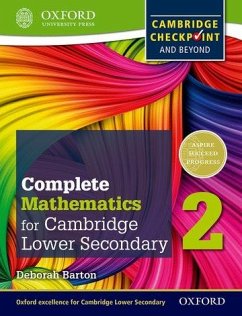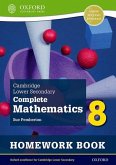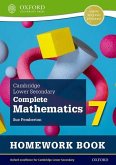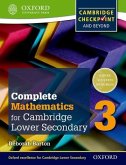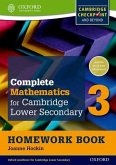Deborah Barton
Complete Mathematics for Cambridge Lower Secondary 2 (First Edition)
Deborah Barton
Complete Mathematics for Cambridge Lower Secondary 2 (First Edition)
- Broschiertes Buch
- Merkliste
- Auf die Merkliste
- Bewerten Bewerten
- Teilen
- Produkt teilen
- Produkterinnerung
- Produkterinnerung
The Complete Mathematics 2 Student Book provides support for the previous Cambridge Lower Secondary Mathematics curriculum.
Andere Kunden interessierten sich auch für
![Cambridge Lower Secondary Complete Mathematics 8: Homework Book - Pack of 15 (Second Edition) Cambridge Lower Secondary Complete Mathematics 8: Homework Book - Pack of 15 (Second Edition)]() Sue PembertonCambridge Lower Secondary Complete Mathematics 8: Homework Book - Pack of 15 (Second Edition)192,99 €
Sue PembertonCambridge Lower Secondary Complete Mathematics 8: Homework Book - Pack of 15 (Second Edition)192,99 €![Cambridge Lower Secondary Complete Mathematics 7: Homework Book - Pack of 15 (Second Edition) Cambridge Lower Secondary Complete Mathematics 7: Homework Book - Pack of 15 (Second Edition)]() Sue PembertonCambridge Lower Secondary Complete Mathematics 7: Homework Book - Pack of 15 (Second Edition)164,99 €
Sue PembertonCambridge Lower Secondary Complete Mathematics 7: Homework Book - Pack of 15 (Second Edition)164,99 €![Complete Mathematics for Cambridge Lower Secondary 3 (First Edition) Complete Mathematics for Cambridge Lower Secondary 3 (First Edition)]() Deborah BartonComplete Mathematics for Cambridge Lower Secondary 3 (First Edition)38,99 €
Deborah BartonComplete Mathematics for Cambridge Lower Secondary 3 (First Edition)38,99 €![Complete Mathematics for Cambridge Lower Secondary Homework Book 3 (First Edition) - Pack of 15 Complete Mathematics for Cambridge Lower Secondary Homework Book 3 (First Edition) - Pack of 15]() Joanne HockinComplete Mathematics for Cambridge Lower Secondary Homework Book 3 (First Edition) - Pack of 15164,99 €
Joanne HockinComplete Mathematics for Cambridge Lower Secondary Homework Book 3 (First Edition) - Pack of 15164,99 €![Cambridge Lower Secondary Complete English 8: Workbook (Second Edition) Cambridge Lower Secondary Complete English 8: Workbook (Second Edition)]() Mark PedrozCambridge Lower Secondary Complete English 8: Workbook (Second Edition)13,99 €
Mark PedrozCambridge Lower Secondary Complete English 8: Workbook (Second Edition)13,99 €![Cambridge Lower Secondary Complete English 7: Workbook (Second Edition) Cambridge Lower Secondary Complete English 7: Workbook (Second Edition)]() Mark PedrozCambridge Lower Secondary Complete English 7: Workbook (Second Edition)15,99 €
Mark PedrozCambridge Lower Secondary Complete English 7: Workbook (Second Edition)15,99 €![Essential Mathematics for Cambridge Lower Secondary Stage 9 Essential Mathematics for Cambridge Lower Secondary Stage 9]() Sue PembertonEssential Mathematics for Cambridge Lower Secondary Stage 937,99 €
Sue PembertonEssential Mathematics for Cambridge Lower Secondary Stage 937,99 €-
-
-
The Complete Mathematics 2 Student Book provides support for the previous Cambridge Lower Secondary Mathematics curriculum.
Produktdetails
- Produktdetails
- Verlag: Oxford University Press
- Seitenzahl: 320
- Erscheinungstermin: 6. Juni 2013
- Englisch
- Abmessung: 254mm x 192mm x 17mm
- Gewicht: 722g
- ISBN-13: 9780199137077
- ISBN-10: 0199137072
- Artikelnr.: 47868965
- Herstellerkennzeichnung
- Libri GmbH
- Europaallee 1
- 36244 Bad Hersfeld
- gpsr@libri.de
- Verlag: Oxford University Press
- Seitenzahl: 320
- Erscheinungstermin: 6. Juni 2013
- Englisch
- Abmessung: 254mm x 192mm x 17mm
- Gewicht: 722g
- ISBN-13: 9780199137077
- ISBN-10: 0199137072
- Artikelnr.: 47868965
- Herstellerkennzeichnung
- Libri GmbH
- Europaallee 1
- 36244 Bad Hersfeld
- gpsr@libri.de
1. Number and calculation 1
1.1: Adding and subtracting integers
1.2: Multiplying negative numbers
1.3: Division of negative numbers
1.4: Squares, cubes, roots and indices
1.5: Multiples and factors
1.6: Mental strategies
2. Expressions and functions
2.1: Simplifying and expanding
2.2: Functions
2.3: Constructing expressions
3. Shapes and mathematical drawings
3.1: Constructing circles, arcs and triangles
3.2: Bisecting angles and lines
3.3: Congruency
3.4: Drawing nets
3.5: Symmetry
4. Length, mass and capacity
4.1: Units of measure
4.2: Units of area, volume and capacity
4.3: Estimation
4.4: Imperial units
5. Number and calculation 2
5.1: Rounding numbers
5.2: Ordering decimals
5.3: Multiplying decimals
5.4: Dividing decimals
6. Planning, collecting and processing data
6.1: Discrete and continuous data
6.2: Collecting data
6.3: Two-way tables and frequency tables
6.4: Averages and ranges
Review A
7. Fractions
7.1: Addition and subtraction of fractions
7.2: Multiplication of fractions
7.3: Division of fractions
7.4: Using known facts and laws of arithmetic to simplify calculations
7.5: Applying order of operations rules to fractions
7.6: Problem solving
8. Expressions, equations and formulae
8.1: Solving linear equations
8.2: Substitution into expressions
8.3: Formulae
9. Geometry
9.1: All about angles
9.2: Angles in common shapes
9.3: Geometry problems using coordinate axes
10. Fractions and decimals
10.1: Ordering decimals
10.2: Adding and subtracting integers and decimals
10.3: Multiplying and dividing decimals
10.4: Writing fractions as decimals
11. Time and rates of change
11.1: Plotting points
11.2: Interpreting real-life graphs
11.3: Drawing graphs
11.4: Travel graphs
12. Presenting data and interpreting results
12.1: Frequency diagrams and pie charts for discrete data
12.2: Line graphs
12.3: Histograms
12.4: Stem-and-leaf diagrams
12.5: Interpreting and comparing data and diagrams
Review B
13. Fractions, decimals and percentages
13.1: Equivalent fractions, percentages and decimals
13.2: Fractions, decimals and percentages of quantities
13.3: Percentage increase and decrease
14. Sequences, functions and graphs
14.1: Rules of sequences
14.2: The nth term
14.3: Functions
14.4: Linear graphs
15. Transformations
15.1: Reflection
15.2: Rotation
15.3: Translation
15.4: Combinations of transformations
15.5: Enlargement
15.6: Scale drawing
16. Ratio and proportion
16.1: Units of measurement
16.2: Ratio
16.3: Proportion
17. Area, perimeter and volume
17.1: Perimeter
17.2: Areas of rectangles and triangles
17.3: Area of a circle
17.4: Areas of parallelograms and trapeziums
17.5: Areas of compound shapes
17.6: Volume of a cuboid
17.7: Surface area
18. Probability
18.1: The idea of probability
18.2: Experimental probability
18.3: Theoretical probability
18.4: Listing outcomes
Review C
19. Vectors and matrices
19.1: Vectors
19.2: Using vectors in geometry
19.3: Matrices
19.4: Multiplying matrices
1.1: Adding and subtracting integers
1.2: Multiplying negative numbers
1.3: Division of negative numbers
1.4: Squares, cubes, roots and indices
1.5: Multiples and factors
1.6: Mental strategies
2. Expressions and functions
2.1: Simplifying and expanding
2.2: Functions
2.3: Constructing expressions
3. Shapes and mathematical drawings
3.1: Constructing circles, arcs and triangles
3.2: Bisecting angles and lines
3.3: Congruency
3.4: Drawing nets
3.5: Symmetry
4. Length, mass and capacity
4.1: Units of measure
4.2: Units of area, volume and capacity
4.3: Estimation
4.4: Imperial units
5. Number and calculation 2
5.1: Rounding numbers
5.2: Ordering decimals
5.3: Multiplying decimals
5.4: Dividing decimals
6. Planning, collecting and processing data
6.1: Discrete and continuous data
6.2: Collecting data
6.3: Two-way tables and frequency tables
6.4: Averages and ranges
Review A
7. Fractions
7.1: Addition and subtraction of fractions
7.2: Multiplication of fractions
7.3: Division of fractions
7.4: Using known facts and laws of arithmetic to simplify calculations
7.5: Applying order of operations rules to fractions
7.6: Problem solving
8. Expressions, equations and formulae
8.1: Solving linear equations
8.2: Substitution into expressions
8.3: Formulae
9. Geometry
9.1: All about angles
9.2: Angles in common shapes
9.3: Geometry problems using coordinate axes
10. Fractions and decimals
10.1: Ordering decimals
10.2: Adding and subtracting integers and decimals
10.3: Multiplying and dividing decimals
10.4: Writing fractions as decimals
11. Time and rates of change
11.1: Plotting points
11.2: Interpreting real-life graphs
11.3: Drawing graphs
11.4: Travel graphs
12. Presenting data and interpreting results
12.1: Frequency diagrams and pie charts for discrete data
12.2: Line graphs
12.3: Histograms
12.4: Stem-and-leaf diagrams
12.5: Interpreting and comparing data and diagrams
Review B
13. Fractions, decimals and percentages
13.1: Equivalent fractions, percentages and decimals
13.2: Fractions, decimals and percentages of quantities
13.3: Percentage increase and decrease
14. Sequences, functions and graphs
14.1: Rules of sequences
14.2: The nth term
14.3: Functions
14.4: Linear graphs
15. Transformations
15.1: Reflection
15.2: Rotation
15.3: Translation
15.4: Combinations of transformations
15.5: Enlargement
15.6: Scale drawing
16. Ratio and proportion
16.1: Units of measurement
16.2: Ratio
16.3: Proportion
17. Area, perimeter and volume
17.1: Perimeter
17.2: Areas of rectangles and triangles
17.3: Area of a circle
17.4: Areas of parallelograms and trapeziums
17.5: Areas of compound shapes
17.6: Volume of a cuboid
17.7: Surface area
18. Probability
18.1: The idea of probability
18.2: Experimental probability
18.3: Theoretical probability
18.4: Listing outcomes
Review C
19. Vectors and matrices
19.1: Vectors
19.2: Using vectors in geometry
19.3: Matrices
19.4: Multiplying matrices
1. Number and calculation 1
1.1: Adding and subtracting integers
1.2: Multiplying negative numbers
1.3: Division of negative numbers
1.4: Squares, cubes, roots and indices
1.5: Multiples and factors
1.6: Mental strategies
2. Expressions and functions
2.1: Simplifying and expanding
2.2: Functions
2.3: Constructing expressions
3. Shapes and mathematical drawings
3.1: Constructing circles, arcs and triangles
3.2: Bisecting angles and lines
3.3: Congruency
3.4: Drawing nets
3.5: Symmetry
4. Length, mass and capacity
4.1: Units of measure
4.2: Units of area, volume and capacity
4.3: Estimation
4.4: Imperial units
5. Number and calculation 2
5.1: Rounding numbers
5.2: Ordering decimals
5.3: Multiplying decimals
5.4: Dividing decimals
6. Planning, collecting and processing data
6.1: Discrete and continuous data
6.2: Collecting data
6.3: Two-way tables and frequency tables
6.4: Averages and ranges
Review A
7. Fractions
7.1: Addition and subtraction of fractions
7.2: Multiplication of fractions
7.3: Division of fractions
7.4: Using known facts and laws of arithmetic to simplify calculations
7.5: Applying order of operations rules to fractions
7.6: Problem solving
8. Expressions, equations and formulae
8.1: Solving linear equations
8.2: Substitution into expressions
8.3: Formulae
9. Geometry
9.1: All about angles
9.2: Angles in common shapes
9.3: Geometry problems using coordinate axes
10. Fractions and decimals
10.1: Ordering decimals
10.2: Adding and subtracting integers and decimals
10.3: Multiplying and dividing decimals
10.4: Writing fractions as decimals
11. Time and rates of change
11.1: Plotting points
11.2: Interpreting real-life graphs
11.3: Drawing graphs
11.4: Travel graphs
12. Presenting data and interpreting results
12.1: Frequency diagrams and pie charts for discrete data
12.2: Line graphs
12.3: Histograms
12.4: Stem-and-leaf diagrams
12.5: Interpreting and comparing data and diagrams
Review B
13. Fractions, decimals and percentages
13.1: Equivalent fractions, percentages and decimals
13.2: Fractions, decimals and percentages of quantities
13.3: Percentage increase and decrease
14. Sequences, functions and graphs
14.1: Rules of sequences
14.2: The nth term
14.3: Functions
14.4: Linear graphs
15. Transformations
15.1: Reflection
15.2: Rotation
15.3: Translation
15.4: Combinations of transformations
15.5: Enlargement
15.6: Scale drawing
16. Ratio and proportion
16.1: Units of measurement
16.2: Ratio
16.3: Proportion
17. Area, perimeter and volume
17.1: Perimeter
17.2: Areas of rectangles and triangles
17.3: Area of a circle
17.4: Areas of parallelograms and trapeziums
17.5: Areas of compound shapes
17.6: Volume of a cuboid
17.7: Surface area
18. Probability
18.1: The idea of probability
18.2: Experimental probability
18.3: Theoretical probability
18.4: Listing outcomes
Review C
19. Vectors and matrices
19.1: Vectors
19.2: Using vectors in geometry
19.3: Matrices
19.4: Multiplying matrices
1.1: Adding and subtracting integers
1.2: Multiplying negative numbers
1.3: Division of negative numbers
1.4: Squares, cubes, roots and indices
1.5: Multiples and factors
1.6: Mental strategies
2. Expressions and functions
2.1: Simplifying and expanding
2.2: Functions
2.3: Constructing expressions
3. Shapes and mathematical drawings
3.1: Constructing circles, arcs and triangles
3.2: Bisecting angles and lines
3.3: Congruency
3.4: Drawing nets
3.5: Symmetry
4. Length, mass and capacity
4.1: Units of measure
4.2: Units of area, volume and capacity
4.3: Estimation
4.4: Imperial units
5. Number and calculation 2
5.1: Rounding numbers
5.2: Ordering decimals
5.3: Multiplying decimals
5.4: Dividing decimals
6. Planning, collecting and processing data
6.1: Discrete and continuous data
6.2: Collecting data
6.3: Two-way tables and frequency tables
6.4: Averages and ranges
Review A
7. Fractions
7.1: Addition and subtraction of fractions
7.2: Multiplication of fractions
7.3: Division of fractions
7.4: Using known facts and laws of arithmetic to simplify calculations
7.5: Applying order of operations rules to fractions
7.6: Problem solving
8. Expressions, equations and formulae
8.1: Solving linear equations
8.2: Substitution into expressions
8.3: Formulae
9. Geometry
9.1: All about angles
9.2: Angles in common shapes
9.3: Geometry problems using coordinate axes
10. Fractions and decimals
10.1: Ordering decimals
10.2: Adding and subtracting integers and decimals
10.3: Multiplying and dividing decimals
10.4: Writing fractions as decimals
11. Time and rates of change
11.1: Plotting points
11.2: Interpreting real-life graphs
11.3: Drawing graphs
11.4: Travel graphs
12. Presenting data and interpreting results
12.1: Frequency diagrams and pie charts for discrete data
12.2: Line graphs
12.3: Histograms
12.4: Stem-and-leaf diagrams
12.5: Interpreting and comparing data and diagrams
Review B
13. Fractions, decimals and percentages
13.1: Equivalent fractions, percentages and decimals
13.2: Fractions, decimals and percentages of quantities
13.3: Percentage increase and decrease
14. Sequences, functions and graphs
14.1: Rules of sequences
14.2: The nth term
14.3: Functions
14.4: Linear graphs
15. Transformations
15.1: Reflection
15.2: Rotation
15.3: Translation
15.4: Combinations of transformations
15.5: Enlargement
15.6: Scale drawing
16. Ratio and proportion
16.1: Units of measurement
16.2: Ratio
16.3: Proportion
17. Area, perimeter and volume
17.1: Perimeter
17.2: Areas of rectangles and triangles
17.3: Area of a circle
17.4: Areas of parallelograms and trapeziums
17.5: Areas of compound shapes
17.6: Volume of a cuboid
17.7: Surface area
18. Probability
18.1: The idea of probability
18.2: Experimental probability
18.3: Theoretical probability
18.4: Listing outcomes
Review C
19. Vectors and matrices
19.1: Vectors
19.2: Using vectors in geometry
19.3: Matrices
19.4: Multiplying matrices

